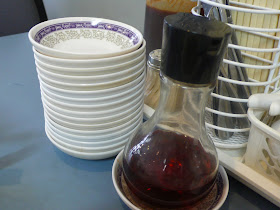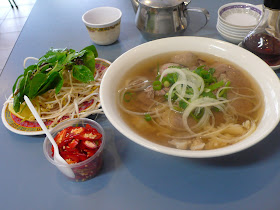Sydney has the largest population of Asians and the largest Chinatown in Australia.
In the southern part of Sydney’s CBD where Chinatown stretches over Haymarket it certainly felt like I was in some Asian city to the point where I almost felt like a tourist in my own country.
On my first day exploring Chinatown, an old Chinese woman stopped me in the street and asked me what the time was in Cantonese and I answered her in Cantonese. It was such a surprise – how did she know that I could speak Cantonese, one of many Chinese languages, what if I had been one of those ABC (Australian Born Chinese) who didn’t know how to speak any Chinese (?!).
(Chinatown Gate)
I was hungry for some pho. I needed a bit of a pick me up after my red eye flight from Perth.
Pho (pronounced "fur") is a Vietnamese rice noodle soup with a clear beef broth, usually garnished with beef meat balls, sliced beef brisket, sliced raw beef, sliced red onion, bean sprouts, mint/basil leaves, chillies and a wedge of lemon. I find it a really hearty meal. Think of a real hearty chicken soup which is a classic comfort food. Pho to me is like chicken soup.
Pho is the most popular Vietnamese dish as evidenced by the number of restaurants which choose to include the word pho in their name – Pho Pasteur, Pho 54, Pho 236, Pho Tau Bay, Pho Bac Hai Duong…
I had done some research before coming to Sydney on the best places to eat pho. I found that a competition had been run earlier this year to find Sydney’s best pho restaurants. In the city Pho Pasteur on 709 George Street was voted the best in the CBD.
I was the first customer in the restaurant at 10am on a Saturday morning (which would have been 7am Perth time!).
As I sat waiting for my pho to come I smiled to myself as I recalled the reviews that I had read of this place on Urbanspoon which criticised this place as having bad service…ha…so true!
“abrupt and steely service”
“service is very bad…rude staff”
“Cheap, quick, efficient but not overly friendly staff”
“Terrible service...but so rude it's funny.”
(Offending saucers)
However, I have to say that I personally don’t have a problem with the service.
I don’t know why so many people had complained about the service.
One has to consider the context in which one is dining. If one is eating out at some fine dining restaurant, extra fringe benefits are expected in the service. But when one is eating at a pho establishement, don’t expect too many comforts or niceties, these Vietnamese noodle houses are about as fancy as your Uni refectory (difference being that the food actually tastes like food). Pretty basic, one could call rustic furnishings, keeping true to how the eatery would be like back in Vietnam. All your cutlery and condiments are placed in bulk on your table so after getting your dish it’s pretty much self-service.
When eating pho, it’s not going to be fancy, but the food will be cheap and delicious! I think people need to cut these Pho places some slack!
The most important thing for me when eating out is the quality of the food and that it arrives within a reasonable time. The cleanliness of the establishment is also important because I don’t want to have the runs the next day. I can tolerate levels of mediocre service as long as everything else meets my requirements.
As a guide for people eating at pho establishments or other low-end places, I suggest applying the ‘harm principle’ to the service that you receive.
The harm principle
The harm principle is the idea (as presented by John Stuart Mill in On Liberty) that “the only purpose for which power can be rightfully exercised over any member of a civilized community, against his will, is to prevent harm to others.”
This principle in applied to the reach of government intervention in society, where the only legitimate reason for the government to exercise power over its citizens is to prevent harm to others.
The harm principle applies not only to the power of the state, it can also be applied to the actions of individuals within society. An individual should have the freedom to do anything he/she wishes, as long as his/her actions do not “harm” others. Harm is generally thought of in a physical sense.
Thus, if you are not “directly harmed” by the service provided.
For example, one of the following things did not happen:
a) The menu that the waiter provides you, gives you a paper cut.
b) When you are about to sit down, instead of pulling your seat out for you, the waiter pulls your seat out from under you.
c) Instead of putting the bowl on the table, the waiter pours the hot steaming bowl of noodles over you, giving you third degree burns.
d) When you ask for additional cutlery, instead of just placing it on the table, the waiter stabs you with them.
e) When you ask for the bill, the waiter presents you with a bird that that tries to bite you with its bill.Then what do you have to really complain about?
Anyway, I digress…
Back to my pho.
The quality of the broth is important. It should be aromatic with spices but not overwhelming. It should have a delicate but complex flavour.
The pho at Pho Pasteur was nice, it had a clean and delicate flavour. However, it did lack something that I have tasted in other phos. I couldn’t pinpoint what it was until I went to Cabramatta Chinatown a few days later and tried the pho at Pho Tay Bau. The pho at Tay Bau was great, really packed a punch and had an amazing whole mouth feeling - a sense of umami.
Bingo! That was it.
I now knew what it was that I felt was lacking from the pho at Pasteur that I could taste in the pho at Tay Bau. You can certainly taste the difference and the difference was the taste of umami! I could tell from the taste of the pho at Tay Bau that it must have had some MSG in it which gave it a special X factor which was lacking in the pho at Pasteur. I’m not sure if this was due to Pasteur not putting any MSG in their pho or maybe not putting enough MSG but the existence of MSG and its effect on the overall taste is unmistakable and not to be dismissed.
MSG!? wtf? People might say.
There is no denying that MSG does get used quite a bit in Asian cooking and it often gets a bad rap.
MSG enhances the taste of food, so what makes it any different from salt or fish sauce?
This makes me recall an article that Michael Ruhlman wrote earlier this year looking at the issue of salt and whether if it was good or bad. Recently, health experts have been urging the government to set mandatory salt limits for food.
MSG could be considered in the same vein as salt, where salt is often complained of being used excessively and contributing to bad health effects.
So I think it’s time for me to set the record straight, and look at the pros and cons of MSG.
MSG is the sodium of glutamate which provides a similar flavouring function as the glutamate that occurs naturally in food (glutamate is 10 times more abundant in human breast milk than in cow’s milk!). MSG is made from starch, corn sugar or molasses from sugar cane or sugar beets and is produced by a natural fermentation process that has been used for centuries to make such common foods as beer, vinegar and soy sauce.
MSG contains only one third the amount of sodium as table salt (13% vs 40%). When MSG is used in combination with a small amount of table salt, MSG can help reduce the total amount of sodium in a recipe by 20 to 40 percent, while maintaining an enhanced flavour.
MSG is used in cooking because it helps to bring out the taste in foods, enhancing flavours and harmonising taste. We have four basic tastes of sweet, sour, salty and bitter. The use of MSG imparts a fifth taste called ‘umami’.
MSG is not bad for your health, it’s pretty harmless. Some people may have sensitivities towards MSG, but then again some people have nut allergies, or are lactose intolerant, or need to eat gluten free foods …
Cooking is all about making something taste good. It doesn’t matter what kind of methods/ingredients you use – it’s the end result that counts.
Hands up if you have ever added in more butter than required by a recipe…..opps did I just add 2 cups of chocolate chips into the cake batter (accidently of course) instead of 1 cup?...and how good is deep fried anything or cooking in fat (confit anyone?)
All the things that “appear” to be bad for us taste the best…
The important thing to note is that you should only add a certain amount of MSG to a dish depending on the ingredients used and how much you are cooking because adding any more MSG or too much will not make a difference and can lead to a decline in flavour. If you are cooking with amino acid rich foods which contain glutamates and are naturally umami rich (for example, tomatoes, mushrooms, cheese, soy sauce, fish sauce), you don’t need to add any MSG. The biggest problem is that it is used far too heavily by some Asian restaurants and without much thought which results in a feeling of an unnatural fullness and you feel thirsty.
MSG DOES NOT MAKE UP FOR CRAP COOKING!
But, used appropriately, is fine.
p.s. There is a band called Notorious MSG with the hit ‘Dim Sum Girl’.









It should be mandatory for restaurants to give you the bill in the bill of a bird. I'm going to start petitioning restaurants now.
ReplyDeleteI hope that the bird will also provide additional services like separate billing otherwise I will file a complaint!
ReplyDeletei love pasteurs Seafood Spring rolls. you'll have to try next time :-)
ReplyDeleteThanks for the recommendation Simon :) I'll definitely check out their seafood spring rolls next time.
ReplyDelete